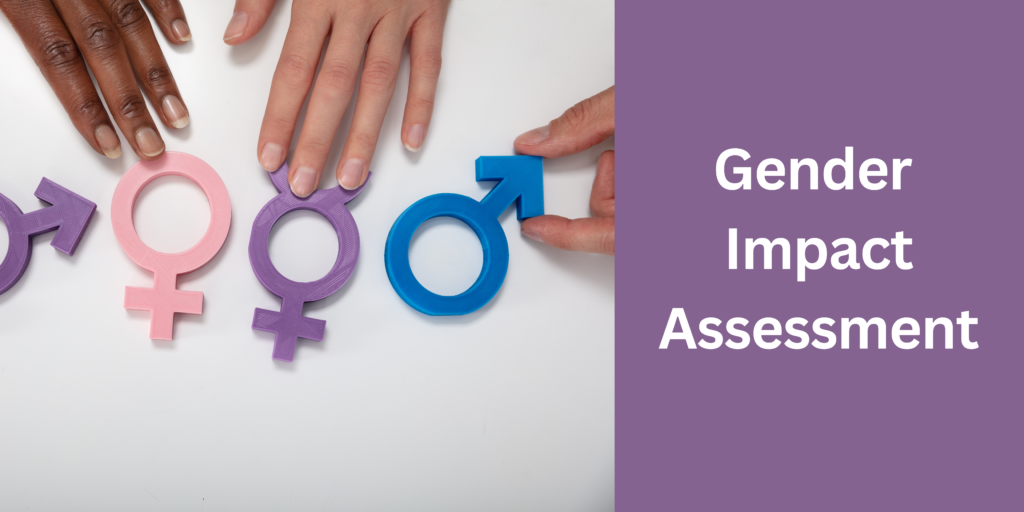
What is Gender Impact Assessment?
Gender impact assessment has been defined as an ex ante evaluation, analysis or assessment of a law, policy or programme that makes it possible to identify, in a preventative way, the likelihood of a given decision having negative consequences for the state of equality between women and men.
The central question of the gender impact assessment is: Does a law, policy or programme reduce, maintain or increase the gender inequalities between women and men?
Gender impact assessment is defined as:
“Gender impact assessment is the process of comparing and assessing, according to gender relevant criteria, the current situation and trend with the expected development resulting from the introduction of the proposed policy.”
“Gender impact assessment is the estimation of the different effects (positive, negative or neutral) of any policy or activity implemented to specific items in terms of gender equality.”
The assessment involves a dual-pronged approach: the current gender-related position in relation to the policy under consideration, and the projected impacts on women and men once the policy has been implemented. It is important that the assessment is structured, i.e. systematic, analytical and documented.
The final aim of the gender impact assessment is to improve the design and the planning of the policy under consideration, in order to prevent a negative impact on gender equality and to strengthen gender equality through better designed, transformative legislation and policies. A primary objective is to adapt the policy to make sure that any discriminatory effects are either removed or mitigated. Beyond avoiding negative effects, a gender impact assessment can also be used in a more transformative way as a tool for defining gender equality objectives and formulating the policy so as to proactively promote gender equality.
Why use Gender Impact Assessment?
Traditionally, government policy and legislation have been viewed as gender-neutral and value-free instruments, on the assumption that the formulation and administration of public policy benefits all members of the public equally. However, structural gender inequalities are still embedded in our society. Even if laws treats women and men as equals, women still do not have equal access to and control over material and non-material resources and assets. That is why addressing people suffering inequalities in an equal way causes, in practice, the perpetuation of these inequalities. That is actually what happens when existing gender inequalities in women’s and men’s economic, political and social position are not taken into consideration. That is why policies focused on target groups defined in broad terms (no distinguishing between women and men) are usually not neutral, but gender blind.
Although it may not be intentional, these policies often impact women and men differently and they may even strengthen social, cultural or economic gender inequalities. If these different gender impacts are not taken into account at the design stage, the policy in question will actually be gender blind. To avoid this, it is necessary to put people at the centre of the intervention, to meet the different needs and interests of women and men, to identify gender inequalities in terms of access to and control of resources, to consider the impact of roles and gender-based stereotypes, to anticipate the possible differential effects on women and men and to ensure that the outcomes of policies will support gender equality.
In this context, gender impact assessment is the first step toward avoiding such unintended effects, as it allows policymakers to foresee the impact of a new regulation, policy or programme on the lives of women and men and the impact on gender equality.
Who should use Gender Impact Assessment?
As gender impact assessment is a tool for gender mainstreaming. Civil servants working for governmental, regional or local offices, departments or ministries initiating a new norm or policy should be involved in the process of gender impact assessment.
There are different ways to carry out a gender impact assessment, depending on the institutional settings and different actors involved. Models can vary depending on the degree of autonomy accorded to civil servants for this task, the assistance provided by gender equality mechanisms and the potential intervention of ‘external’ actors such as gender or legal experts.
Relevance of gender impact assessment
Gender impact assessment can be applied to legislation, policy plans, policy programmes, budgets, concrete actions, bills and reports or calls for research. Gender impact assessment methods do not only have to be applied to policy in the making, they can also be applied to existing policies. They can be used in the administration as well as external actors; in both cases they require a considerable amount of knowledge of gender issues.
Most political decisions have a concrete impact on the lives of women and men. That is why in most cases gender impact assessment is relevant and needed in order to assess the effects of the decisions on both sexes – to evaluate the foreseen impact from gender perspective and to ensure that the proposed legislation/programme will enhance gender equality. Consequently, all proposals/legal acts meeting those criteria should go through a gender impact assessment. Nevertheless, any proposal considered not relevant from a gender point of view should be accompanied by a supporting report, explaining the reasons why gender is not relevant.
